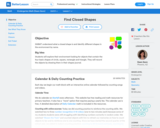
Which drink has the strongest caffeine concentration? Students work on this problem for the second of two lessons.
- Subject:
- Mathematics
- Material Type:
- Lesson Plan
- Provider:
- BetterLesson
- Date Added:
- 12/01/2022

Which drink has the strongest caffeine concentration? Students work on this problem for the second of two lessons.

Students understand what a closed shape is and identify different shapes in the environment by name.

The three types of angles, right, acute, and obtuse, exist in our everyday surroundings. Students find these angles using classroom items.

Students decompose an irregular polygon into arrays to find the area.

Students will be able to compare groups of objects to decide if they are equal with this lesson. Included are pictures and videos of the lesson in action, worksheets, and a SMART Board resource.

Using number lines and fraction strips helps students become familiar with benchmark fractions, equivalent fractions, and comparing fractions.

Students can solve real world problems using their understanding of multiplication and division and the relationship they share.

Students find the area of rectangles, triangles, parallelograms, and trapezoids by using formulas or by composing into rectangles or triangles.

Students find the area of parallelograms by using square units and the area formula.

Students use the area formula for rectangles to solve real world and mathematical problems.

Students find the area of a trapezoid by decomposing it into triangles and using the formula

Students find the area of a triangle using square units and the area formula.

What is autism? How does it affect behavior? Students will find evidence of the author's tone or purpose for writing the article, as well as hints that show evidence of opinion. Includes a video clip from the movie "Rainman", and an article about autism to read and annotate.

Students read a poem to see the importance of class rules and behaviors.

Students will role play with the teacher to reinforce classroom procedures.

Students tell how long an object is by measuring it using paper clips and comparing it to other objects measured with the same non-standard unit of measurement.

Students sort objects according to whether they sink or float.

Students will compare sets of numbers using symbols for greater than, less than, and equal to.

Students will create a food chain model and use it to describe the movement of matter among plants, animals, decomposers, and the environment. Resources include a detailed lesson plan, student handouts, pictures of a completed chain, examples of student work, and a video of the lesson in action.

Students will build a food web diagram and illustrate the movement of matter through a series of food chains. Resources include detailed plans, examples of student work, videos of the lesson in action, and sample food webs.